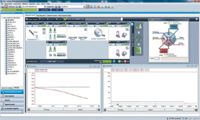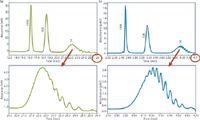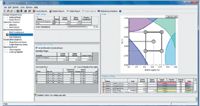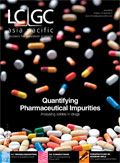HPLC Systems and Modules Introduced at Pittcon 2013: A Brief Review
The first instalment of the Perspectives in Modern HPLC column highlights some of the new HPLC systems, accessories and related technology introduced at Pittcon this year.
This is the first instalment of "Perspectives in Modern HPLC", a new column that will be published every quarter on this topic. Here, we highlight prominent high performance liquid chromatography (HPLC) and related products introduced at Pittcon 2013, as well as the previous year. A summary of technical details is provided for these new HPLC systems, modules and chromatographic software products, and major product extensions are also presented. The focus is on innovations and unique features from a user's perspective.
The Pittsburgh Conference on Analytical Chemistry and Applied Spectroscopy (Pittcon) is the world's largest annual conference and exposition on laboratory science. It is organized by The Spectroscopy Society of Pittsburgh and Society for Analytical Chemistry of Pittsburgh and is managed by a committee of volunteers with a small permanent staff. Pittcon 2013 was held at the Pennsylvania Convention Center in Philadelphia, USA, from 17–21 March, the first time in recent memory to be held in the northeastern United States (the last time was 1990 in New York City). Despite a trend of declining participation by exhibitor staff in recent years, Pittcon remains the premier analytical chemistry conference, unmatched in scope or scale by any contenders. This year, Pittcon boasted more than 18,000 attendees from industry, academia and government agencies from more than 90 countries. There were more than 2000 technical sessions, including plenary lectures and invited, contributed and award symposia; workshops; posters and networking sessions; ~90 short courses; and a huge exposition with more than 1000 vendors displaying at ~1900 booths.
Traditionally, Pittcon is the forum for new product introductions and a "must-go-to" conference for laboratory scientists looking for new equipment. However, the many meetings with narrower focuses such as mass spectrometry, high performance liquid chromatography (HPLC), chiral separations and biotech applications continue to compete for attendees. More importantly, the new information age now offers convenient alternatives for information gathering (such as Google searches, webcasts, virtual meetings and social media). Nevertheless, the opportunities for face-to-face meetings to renew acquaintances and continuing education from symposia or short courses still hold sufficient motivation for many in this annual pilgrimage.
Overview and Megatrends in Modern HPLC
In my opinion, the transformation from HPLC to ultrahigh-pressure liquid chromatography (UHPLC) is essentially complete this year. The revolution (or evolution) started with the proof-of-concepts research by Professor James Jorgenson in 1997 (1), followed by the first commercial UHPLC instrument (Waters Acquity UPLC) in 2004 (2). UHPLC is becoming the standard HPLC platform as all major manufacturers have some type of UHPLC system in their product line (3–5) with pressure limits ranging from 15,000 to 19,000 psi (1000–1250 bar). Acceptance by users is pervasive, including the very conservative quality control segment. The dissenting voices of sceptics have disappeared. In a few years, with universal adoption of this new technology, the term "UHPLC" may simply revert back to HPLC. It is noteworthy that Professor Jorgenson predicted faster and higher-resolution HPLC in small-internal-diameter columns packed with very small particles with further development of equipment with higher pressure capability (that is, 50,000 psi) (6):
Moving to still higher pressures (50,000 psi) will enable the use of smaller particles and/or longer columns, and yield faster and better separations. This will almost certainly require the use of sub-mm bore (capillary) columns due to issues with heat generation and dissipation. This won't be easy, but the separation potential in terms of high speed with high resolution is enticing.
Table 1 lists new HPLC product introductions (alphabetically by vendor) at Pittcon 2013 or in the prior year, followed by descriptions and commentaries of each product, categorized as systems, modules, data systems and software.

Table 1: Summary of new HPLC product introductions at Pittcon 2013.
UHPLC Systems and Line Extensions
2013 appears to be a lean year for HPLC introductions. With most manufacturers having UHPLC systems in their product line, vendors are offering product extensions or specialized applications systems. The following are some examples of new systems or system extension offerings.
Agilent 1290 Infinity Quaternary LC system — Low-pressure mixing quaternary UHPLC pumps are available from many manufacturers and generally have lower pricing but less desirable higher delay volumes. Agilent has closed the gap this year with the introduction of the 1290 Infinity quaternary pump equipped with an innovative inlet Jet Weaver mixer. The pump has a delay volume of ~350 µL and is designed for HPLC method development. This quaternary pump has a lower price than the 1290 Infinity binary pump (~20%) and can operate with a "software-selectable" post-pump mixer for high-sensitivity applications.
Agilent 1290 Infinity 2D-LC system — Two-dimensional LC (2D-LC) is a useful platform technology for complex samples such as proteomics, metabonomics, biopharmaceuticals, peptide maps, biofluids, plant extracts, food matrices, polymers and genotoxic impurities. Several manufacturers have 2D-LC offerings and their ranks are joined by Agilent this year. Agilent's 2D-LC system uses 1260/1290 Infinity system hardware in the first dimension and a 1290 Infinity binary pump in the second dimension. It uses specialized valving for comprehensive or heart-cutting operation. The system's multiple detectors can all be configured and controlled by a single Agilent ChemStation chromatography data system (CDS). (See Figure 1 for a screen display of the enhanced OpenLab CDS ChemStation edition software version capable of both system control and data handling for both dimensions from the 2D-LC system).

Figure 1: Agilent Infinity 2D-LC Solution - OpenLab ChemStation with direct control and data handling for both dimensions (software screen display for dual systems control and valving configuration shown here).
Bio-Rad NGC chromatography system — This system is a new medium-pressure PEEK-based protein purification system. It is a flexible, modular plug-and-play system with easy-to-use touch-screen software for module configuration, system or method control, and data handling and display. Two pump modules are available (for 10- and 100-mL/min flow rate capabilities with pressure limits of 3650 psi or 1450 psi, respectively). Optional modules can be plugged into a highly flexible system frame and include sampling pumps, mixers, detectors (UV single or multiple-wavelength, conductivity, pH monitoring), injector or autosampler, column switching valves and fraction collectors. This system targets biomolecule purification at the research, process development and laboratory-scale levels.
Hitachi Primaide HPLC system — Hitachi High Technologies America has focused on the lower-cost HPLC market segment for routine testing and quality control. Primaide (pronounced as "prime aide") is the first 6000-psi system in the series featuring "affordability" for routine testing. Only UV–vis and photodiode-array detectors are available. System control and data handling are performed using Primaide System Manager, Agilent OpenLAB or EZChrom software.
The Shimadzu's Nexera X2 UHPLC system — This second-generation system targets routine analysis in regulated environments demanding complex system setups. New modifications and options include an improved inlet valve, an enhanced degassing unit, a low-delay-volume quaternary pump and an improved SPD-M30A photodiode-array detector with higher thermal stability, sensitivity (noise = 0.4 × 10-5 AU) and spectral resolution. The system's standard flow cell has a volume of 1 µL with a pathlength of 10 mm. A high-sensitivity flow cell with an 85-mm pathlength will be available shortly. A unique iPDeA (intelligent peak deconvolution analysis) software allows for better quantitation of coeluting peaks by using a peak deconvolution algorithm based on spectral characteristics of the analytes. Figure 2 shows comparative baseline data of the SPD-M30A detector vs. that of a competitor's product in varying room temperature environments.

Figure 2: Comparative detection baseline traces vs. room temperature changes demonstrating the improved thermal stability of the SPD-30MA detector in the Shimadzu Nexera X2 UHPLC vs. that of a competitor’s product.
Thermo Scientific Dionex UltiMate 3000 Biocompatible Rapid Separation (BioRS) system — Bioinert UHPLC systems designed for use in harsh, high-salt mobile phases for analysis of biomolecules have become available in prior years from several vendors. This new titanium-based UHPLC system is designed to support high-resolution separations for biopharmaceutical R&D and quality control applications at pressures as high as 15,000 psi. The system was introduced with a new line of ion-exchange and hydrophilic interaction liquid chromatography (HILIC) columns for the analysis of recombinant biopharmaceuticals, monoclonal antibodies, proteins, peptides and DNA. Options include a wide selection of pumps, detectors and fraction collectors. Figure 3 shows an example of its precision performance in high-resolution peptide mapping.

Figure 3: Overlaid chromatograms of 14 peptide maps demonstrating the performance of the Thermo Scientific Dionex 3000 Ultimate BioRS UHPLC system.
Thermo Scientific Dionex ICS-5000+ Reagent-Free HPIC system — This system is the first PEEK-based reagent-free ion chromatography system capable of continuous operation at pressures as high as 5000 psi that is designed to work with capillary, microbore or standard columns. Applications supported include high-speed and high-resolution analysis of anions, cations, organic acids, amines, carbohydrates and amino acids. This system debuted with the new ICS-4000 QD charge detector; charge detection is a low-cost detection technique with universal and linear calibration supplementing the traditional suppressed conductivity detection.
The Waters Acquity Advanced Polymer Chromatography (APC) system — This low-dispersion gel permeation chromatography (GPC) system is optimized for the analysis of organic polymers in aqueous and organic mobile phases. The system features a new refractive index (RI) detector designed for a new set of sub-3-µm hybrid polymer columns. Key benefits are faster analysis, higher sensitivity and accurate measurements of molecular weights and distribution. System control and data handling is performed by Waters Empower 3 CDS with an optional GPC software. Figure 4 shows the comparative performance of this new system–column combination vs. that of a conventional system in polymer analysis.

Figure 4: Polymer analysis chromatograms comparing the performance of (a) a conventional GPC system with (b) Waters Acquity APC system with a new set of 3-µm hybrid columns. Columns: (a) 300 mm à 7.8 mm Styragel (3X); (b) 150 mm à 4.6 mm Waters APC (3X).
HPLC Modules
Several modules introduced as stand-alone units are described here.
Agilent 1260 and 1290 Infinity evaporative light scattering detector — This evaporative light-scattering detection (ELSD) system provides sensitive detection and gives a near-universal response for low- or nonchromophoric, nonvolatile compounds. The unit is adaptable to both HPLC and supercritical fluid chromatography (SFC) and has a subambient mode for detection of semivolatiles and a standby mode for reduced nitrogen consumption.
PerkinElmer Aurora photodiode-array (PDA) detector — This new detector has improved performance specifications (better wavelength accuracy and low noise, drift, and stray light) and enhanced low-dispersion flow cells (1 µL and 5 µL with pathlengths of 10 mm and 50 mm, respectively).
Scientific Systems, Inc. (SSI) HF Series pump — This pump is designed for preparative LC and column packing operations. The high-performance, relatively low-cost, dual-head pump is capable of delivering precise flow rates as high as 300 mL/min at pressures as high as 10,000 psi.
Wyatt Technology Optilab UT-rEX RI detector — Wyatt Technology, known for its innovative instrumentation and software for absolute macromolecular characterization, has developed a new RI detector. Wyatt claimed this detector to be the first RI detector designed for UHPLC. It is equipped with a 1.5-µL flow cell. It has excellent sensitivity and linearity performance, and can operate in temperature ranges of 4–50 °C. It is compatible with UHPLC systems from all manufacturers.
Chromatography Data Systems
Chromeleon 7.2 — Thermo Scientific Dionex introduced a major upgrade to its flagship client–server network CDS, Chromeleon. The new version 7.2 has an improved graphical user interface (GUI) built on the Windows dot.net framework. This CDS boasts a more effective mass spectral data interface for viewing data from both LC–mass spectometry (MS) and gas chromatography–mass spectrometry (GC–MS), a common weakness for CDS software.
HPLC Method Development and Other Software
S-Matrix QbD LC method development software for Agilent ChemStation — S-Matrix Corporation has offered Fusion AE HPLC method development software (FMD) for Waters Empower for several years. It now offers a similar product for Agilent ChemStation/OpenLab. FMD automates method development experiments via principles of design of experiments (DoE) and quality by design (QbD). The new version has enhanced experiment design features to automate the on-line preparation of mobile phases to study variables such as buffer or salt concentration and pH.
Another software product of interest is the company's LC Method Validation (FMV) software, which automates the time-consuming method validation process required for good manufacturing practices (GMP). FMV provides a full suite of method validation experiments for multiple compounds, including rigorous robustness testing. FMD and FMV now fully automate these experiments on Agilent's Infinity Series or 1100/1200 LC systems. Figure 5 shows a screen display of the Fusion AE software program demonstrating its feature for graphical visualization of design space and proven acceptable ranges of an optimized method from a DoE run.
Spectrus Data Base — ACD's AutoChrom Method Development System software is now available with a new Spectrus Data Base feature to provide enhanced back-end connections for better data management and integration.

Figure 5: Fusion AE LC method development software screen display showing visualization of design space and proven acceptable ranges from an optimized method.
Agilent Intelligent System Emulation Technology (ISET), 2nd release — This software is designed to facilitates methods transfer and method robustness evaluations. This new version allows the Agilent Infinity 1290 system to execute legacy methods using Waters Alliance LC systems to obtain similar chromatographic results by operating the 1290 system under an Alliance emulation mode without physically modifying the methods or system hardware.
Summary and Commentaries
This review summarizes new HPLC product introductions (systems, modules, chromatography data systems and software) at Pittcon 2013 and in the prior year. It highlights innovative features and technical details of these new products or extensions from a user's perspective. The process of collecting information for this review started in December 2012 with questionnaires sent to all HPLC manufacturers to solicit information on pending product introductions. This was followed-up with direct communication to marketing staff and actual visits to the Pittcon exposition booths. My goal was to be inclusive, thorough and objective, with a focus on relevant innovations of interest to our readership. Note that new HPLC columns introduced at Pittcon are covered by Ron Majors in his "Column Watch" annual Pittcon review series.
Personally, I continue to be baffled by vendors electing not to showcase their equipment at Pittcon. I do understand the many rationales of alternative marketing strategies, tight budgets, rising travel costs and return-on-investment considerations. Nevertheless, missing Pittcon means missing the huge opportunities for face-to-face meetings with a vast pool of potential customers, old friends and new scientists as well as missing the excitement to see new competitive products on the exposition floor. After all, Pittcon is the premier global analytical chemistry conference with a tradition of excellence for 64 years. In my view, a continuing presence by a manufacturer, albeit with smaller floor spaces and core staff, is clearly preferred over a sporadic showing or complete absence in this global annual venue.
The opinions expressed in this article are solely those of the author and bear no reflections on those from LCGC magazine, the Pittsburgh Conference, or other organizations. Inaccuracies and inadvertent omissions are the responsibilities of the author alone.
Acknowledgments
The author thanks the marketing staff of all manufacturers who provided timely responses to the LCGC questionnaires. The author is grateful to Drs. Davy Guillarme of University of Geneva and Raphael Ornaf of Vertex Pharmaceuticals, and Marian Nardozzi of Pittcon for providing useful inputs and comments.
Michael W. Dong is a senior scientist in Small Molecule Drug Discovery at Genentech in South San Francisco, California, USA. He is responsible for new technologies, automation and supporting late-stage research projects in small molecule analytical chemistry and QC of small molecule pharmaceutical sciences. He holds a PhD in analytical chemistry from the City University of New York, USA, and a certificate in Biotechnology from U.C. Santa Cruz, USA. He has conducted numerous courses on HPLC/UHPLC, pharmaceutical analysis, HPLC method development, drug development process and drug quality fundamentals. He is the author of Modern HPLC for Practicing Scientists and a co-editor of Handbook of Pharmaceutical Analysis by HPLC. He is a member of the editorial advisory board of LCGC North America.
References
(1) J.E. MacNair, K.C. Lewis and J.W. Jorgenson, Anal. Chem. 69, 983–989 (1997).
(2) K.J. Fountain and P.C. Iraneta, in UHPLC in Life Sciences, D. Guillarme, J.-L. Veuthey and R.M Smith, Eds. (Royal Soc. Chem., Cambridge, UK, 2012), Chapter 2.
(3) M.W. Dong, LCGC North Amer. 25(7), 656–666 (2007).
(4) UHPLC in Life Sciences, D. Guillarme, J.-L. Veuthey and R.M. Smith, Eds. (Royal Society of Chemistry, Cambridge, UK, 2012).
(5) M.W. Dong, "UHPLC in Pharmaceutical Analysis: Perspectives, Practice and Potential Issues," presented at The Pittsburgh Conference on Analytical Chemistry and Applied Spectroscopy (Pittcon), Philadelphia, Pennsylvania, 2013.
(6) J. Jorgenson, "Future Trends in UHPLC," presented at The Pittsburgh Conference on Analytical Chemistry and Applied Spectroscopy (Pittcon), Philadelphia, Pennsylvania, 2013.

New Study Reviews Chromatography Methods for Flavonoid Analysis
April 21st 2025Flavonoids are widely used metabolites that carry out various functions in different industries, such as food and cosmetics. Detecting, separating, and quantifying them in fruit species can be a complicated process.
Quantifying Terpenes in Hydrodistilled Cannabis sativa Essential Oil with GC-MS
April 21st 2025A recent study conducted at the University of Georgia, (Athens, Georgia) presented a validated method for quantifying 18 terpenes in Cannabis sativa essential oil, extracted via hydrodistillation. The method, utilizing gas chromatography–mass spectrometry (GC–MS) with selected ion monitoring (SIM), includes using internal standards (n-tridecane and octadecane) for accurate analysis, with key validation parameters—such as specificity, accuracy, precision, and detection limits—thoroughly assessed. LCGC International spoke to Noelle Joy of the University of Georgia, corresponding author of this paper discussing the method, about its creation and benefits it offers the analytical community.











